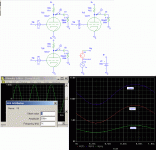jan.didden,
I have risked tubes by using battery bias.
And, the DCR of the primary is much smaller than the primary impedance.
I have used both 2A3s and 300Bs very successfully that way.
But, if something goes wrong, there may be Lots of current.
The first thing about this kind of output stage, is that you do Not run the tube at or near its maximum specified voltage, current, plate dissipation, maximum grid circuit resistance, etc.
Conservative operation rules the day.
When a tube ages and goes soft, and you still want optimum performance . . .
then replace it, no matter what kind of circuit topology it is in.
But . . .
What if you use a self bias resistor and bypass cap?
Or adjustable fixed bias?
Or Zener bias?
Or a limited voltage range/power dissipation constant current sink? . . .
And then the tube shorts!
Yes, I have seen more than one 300B short the grid to the filament (0 bias).
Do not think I am proposing only one solution.
I have used adjustable fixed bias, self bias, constant current sink bias, and battery bias (each one worked, each had advantages and disadvantages)
All circuits have some risk.
"All generalizations have exceptions" - me
I have risked tubes by using battery bias.
And, the DCR of the primary is much smaller than the primary impedance.
I have used both 2A3s and 300Bs very successfully that way.
But, if something goes wrong, there may be Lots of current.
The first thing about this kind of output stage, is that you do Not run the tube at or near its maximum specified voltage, current, plate dissipation, maximum grid circuit resistance, etc.
Conservative operation rules the day.
When a tube ages and goes soft, and you still want optimum performance . . .
then replace it, no matter what kind of circuit topology it is in.
But . . .
What if you use a self bias resistor and bypass cap?
Or adjustable fixed bias?
Or Zener bias?
Or a limited voltage range/power dissipation constant current sink? . . .
And then the tube shorts!
Yes, I have seen more than one 300B short the grid to the filament (0 bias).
Do not think I am proposing only one solution.
I have used adjustable fixed bias, self bias, constant current sink bias, and battery bias (each one worked, each had advantages and disadvantages)
All circuits have some risk.
"All generalizations have exceptions" - me
Last edited:
This is dangerous practice. How will you keep the tube in its design range with ageing, and changing new tubes?...
You keep the tube in line by using a brain.
The "20k" is not a good plan; I assume that was just on a clip-board.
You usually see small battery bias with LOW level stages (microphone, not line) and with 100k-470k plate resistor.
The usual tubes, with such a large plate resistor, will NOT burn-up, and do not go too far into cutoff.
My sim models do not have a "drift/aging" knob. But I can "drift" a 12AX7 into a 12AU7. The amplifier amplifies with any of these tubes. Yes, the AX gives 2.5X the gain, but that's far short of the 100/20= 5:1 change of Mu.
A triode is very robust against self-drift.
FWIW, back in the 1920s Bell Labs actually advocated battery bias for ALL small tubes not located in remote shacks. They felt it gave better balance against the drifts or the tubes of that day. (Also tubes were expensive while batteries and technicians were cheap.....)
Yes, the battery voltage should be picked in consideration of B+ and Mu. But some variation around "optimum" does not cause crap-out.
Attachments
For resistively loaded valves, maximum dissipation is where the valve sees half of the supply voltage, around the usual idle condition. Not true for the loading resistor though.
All good fortune,
Chris
All good fortune,
Chris
> maximum dissipation is where the valve sees half of the supply voltage
75^2/150k is 0.0375 Watts. Not dangerous.
75^2/150k is 0.0375 Watts. Not dangerous.
Yep. The part about the resistors is just interesting, not fatal. Output stages are of course another different critter.
All good fortune,
Chris
All good fortune,
Chris
